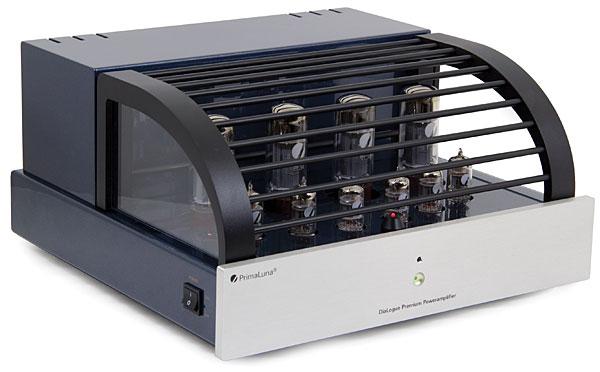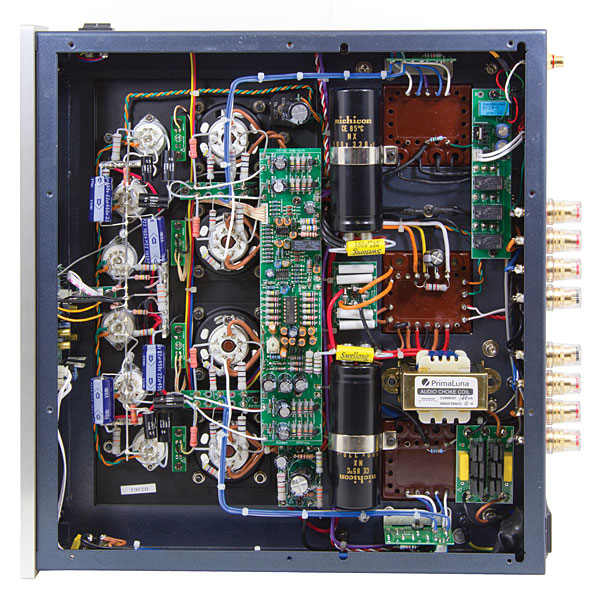| Columns Retired Columns & Blogs |
Correct me if I am wrong; but shouldn't this be called PrimaChina?

The DiaLogue tube amplifiers from PrimaLuna have, at their heart, a clever idea of their own: an output circuit that is user-switchable between triode operation, in which the screen grid of a tetrode or pentode power tube is defeated by means of connection to the tube's anode; and Ultralinear operation, in which the screen grid of a tetrode or pentode carries a portion of the AC music signal, supplied by a tap on the output-transformer primary, in a feedback-like effort to reduce distortion and increase power. Fans of the former often report a sweeter, more tubey sound, while fans of the latter report a tighter, more detailed, more timbrally neutral sound. Audio enthusiasts are given to reporting any number of things.
Here's the difference between PrimaLuna's clever invention and all of those self-centering turntable platters and "sonic hologram" generators: None of the latter really caught on in the long run, their makers having moved on to ever more newsworthy gewgaws, while PrimaLuna's Triode/Ultralinear circuitry has endured since 2006—and has apparently succeeded in the marketplace. (The company itself got started in 2000.) It has also spread to even more products in the PrimaLuna line, the most recent being the DiaLogue Premium amplifier ($3199), which offers 25Wpc in triode mode, 42Wpc in Ultralinear.
Description
The PrimaLuna DiaLogue Premium has more than one clever trick up its sleeve. Flip the rocker switch on the right side of its chassis and this erstwhile EL34 amplifier can now accept power tubes from the KT88/KT120 family of pentodes. Flip a switch on the rear panel and this stereo amplifier is now strapped for use as a higher-powered monoblock, after which you have a choice of buying one more DiaLogue Premium or discarding one of your loudspeakers. (You know which route I'd go.) Sit back and ignore both of those switches and the DiaLogue Premium still offers: an LED-based Bad Tube Indicator system for the output tubes; a Power Transformer Protection circuit; an Output Transformer Protection circuit; and an AC Offset Killer circuit intended to eliminate hum and promote more silent spaces between the notes. Choices!
Enduring in the DiaLogue Premium amplifier is an updated version of a design innovation that has, from day one, characterized all of PrimaLuna's amplifiers: their Adaptive AutoBias circuit. In contrast with the traditional application of the term, whereby an auto-bias circuit is one in which the signal grid automatically takes on a negative bias relative to the cathode simply by using a resistor to raise the latter above ground, PrimaLuna's Adaptive AutoBias keeps the cathode at or near ground, and applies to the signal grid a negative voltage that is subject to continual change, in response to amplifier demands and the aging of the power tubes (footnote 1).
Back to the Triode/Ultralinear choice: In the last PrimaLuna amp I reviewed, the DiaLogue Seven monoblock (see Stereophile, January 2010), chief designer Herman van den Dungen and his engineering team effected that switching capability by putting two separate output transformers into each mono amplifier. Yet in a stereo amplifier such as the DiaLogue Premium, a total of five large transformers—two Ultralinear output transformers, two triode output transformers, and one sizable power transformer—would add to the product unwanted weight, bulk, and electromagnetic fields. Thus the DiaLogue Premium has only a single stereo pair of output transformers, the primary sides of which are bordered by small circuit boards containing relays and transistors, presumably to reconfigure, on the fly, the various primary taps.

Indeed, small circuit boards stuffed with relays and transistors are the order of the day here—the AC Offset Killer board alone has a full dozen transistors—yet these are not in the signal path, which itself is executed with conspicuously neat point-to-point wiring and such high-quality parts as Solen capacitors, Takman resistors, and robust ceramic terminal strips. The DiaLogue Premium has three 12AU7 small-signal tubes per channel, including voltage-gain stages and a long-tailed pair for phase inversion. The power supply uses silicon devices for rectification—individual diodes for the rail, a full-wave bridge rectifier for the heaters—followed by a pi filter incorporating two large Nichicon reservoir caps and a neat proprietary choke. As I've found is typical of PrimaLuna, whose products are designed in the Netherlands and assembled in China, the build quality of the DiaLogue Premium's circuitry and casework is excellent.
Installation and setup
One could easily go overboard writing about the PrimaLuna DiaLogue Premium: Here's how it sounded with EL34s in triode mode, and the same tube in Ultralinear mode, and the KT88 in triode, and . . .
Because the amp is supplied with EL34 power tetrodes as standard, that's where I started. And because the review sample, as shipped, was set to Ultralinear mode, and because the remote handset, which controls only that function, arrived with a dead 2032 3V battery, and because that function can't be controlled from the amp itself . . . well, that, too, is where I started.
I enjoyed the detailed and pleasantly punchy sound of the Premium in EL34 Ultralinear mode. But when I refreshed the handset's battery and restored the Premium's switchability, I was even more impressed with the amplifier's Triode-mode performance, which, through my very sensitive Altec Valencia speakers, had a more pleasing and more "organic" bottom-to-top balance of performance, while appearing to sacrifice nothing in terms of detail or temporal accuracy.
And then, when I replaced the Premium's stock, PrimaLuna-branded EL34 tubes with the Russian-made Tung-Sol KT120s sent to me, for trial, by PrimaLuna distributor Kevin Deal, I was even more impressed with those—an $80 option at time of purchase. I also preferred to use the KT120s in Triode mode.
To confirm those impressions, I did a considerable amount of switching, back and forth, of tubes and switches. And there came a day when I discovered that I'd spent a few hours listening with KT120 power pentodes, but with the tube-selector switch—which controls bias voltage—set for EL34. After making the correction, I noticed that not only was the switch's effect subtle, but that I actually enjoyed the sound of the KT120 tubes set for EL34 bias.
Curious, I opened up the DiaLogue Premium and made a few cursory measurements, at which time I discovered that the position of the selector switch makes a difference of less than 2V for the same tube: –54.6V when set for KT120s vs –56.4V when set for EL34s. (I suppose one might see more or less of a voltage difference when changes in switch position are accompanied by changes in power tubes, given that different tubes can draw different amounts of current.)
Be that as it may: The reader should note that all of the listening observations that follow were based on the DiaLogue Premium used with KT120 power tubes operating in Triode mode, with the tube-selector switch set for KT88/KT120.

Correct me if I am wrong; but shouldn't this be called PrimaChina?

I happen to own the Prologue Power and Dialogue Pre-amps, and thought this review was spot on and in-line with Primaluna values and built qualities. Will PrimaAmerica or PrimaEuro indicates quality, if made there with exorbitant pricing?